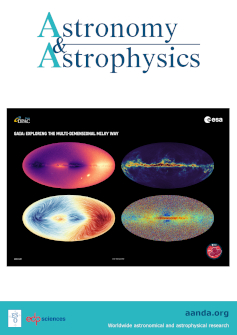从 eROSITA 发现中对双子座-望夫石 X 射线增强的新认识
IF 5.4
2区 物理与天体物理
Q1 ASTRONOMY & ASTROPHYSICS
引用次数: 0
摘要
目的双子座-木卫二 X 射线增强是研究漫射 X 射线发射和超新星残余(SNR)的一个丰富领域。这部分天空中的大多数超新星残骸由于范围大而难以观测。随着 2019 年搭载在 Spektrum-Röntgen-Gamma 平台上的扩展伦琴巡天成像望远镜阵列(eROSITA)的发射,我们现在第一次能够以 CCD 分辨率对这些天体进行全面研究。附近的许多自发核反应堆被怀疑是非常古老的残余物,由于观测方面的诸多挑战,它们在 X 射线方面的研究严重不足。此外,发现新的暗弱大型自发核反应堆可能有助于解决银河系自发核反应堆的观测数量与预期数量之间长期存在的差异。我们对整个双子座-莫诺塞洛斯 X 射线增强区进行了详细的 X 射线光谱分析,并对附近地区进行了详细的背景分析,从而能够对 X 射线增强区内的背景进行高精度建模。我们还利用多波长数据来更好地了解其形态,并对不同来源的距离进行约束。在光谱分析的基础上,我们估算了源的属性,并计算出了一个 SNR 模型网格,以确定单个 SNR 的属性。Monogem Ring SNR 的大部分弥漫等离子体都可以用平均温度为 kT = 0.14 ± 0.03 keV 的单一非平衡电离(NEI)成分很好地描述。我们得到了 Monogem Ring 的年龄≈1.2 × 105 年--与 PSR B0656+14 一致,爆炸能量为典型的核坍缩(CC)超新星(SN)。在东南部,我们发现了温度显著升高和第二个等离子体成分的证据。我们的研究结果表明,在≈300 pc处可能存在两个SNR,新的候选SNR的年龄≈50000年。我们还通过分离Monogem Ring SNR的前景弥散发射,改进了以前对Monoceros Loop和PKS 0646+06 SNR的研究结果。我们得到的温度明显高于之前的研究,而对于 PKS 0646+06 SNR,估计的年龄要低得多。我们还发现了一个新的SNR候选者G190.4+12.5,它很可能位于D > 1.5 kpc处,在距离银河系平面很远的地方向低密度介质膨胀,估计年龄为40000-60000年。本文章由计算机程序翻译,如有差异,请以英文原文为准。
A new understanding of the Gemini-Monoceros X-ray enhancement from discoveries with eROSITA
Aims. The Gemini-Monoceros X-ray enhancement is a rich field for studying diffuse X-ray emission and supernova remnants (SNRs). Most SNRs in this part of the sky are notoriously difficult to observe due to their large extent. With the launch of the extended ROentgen Survey with an Imaging Telescope Array (eROSITA) on board the Spektrum-Röntgen-Gamma platform in 2019, we are now able to fully study those objects for the first time with CCD resolution. Many of the SNRs in the vicinity are suspected to be very old remnants, which are severely understudied in X-rays due to numerous observational challenges. In addition, the identification of new faint large SNRs might help to solve the long-standing discrepancy between the observed and expected number of Galactic SNRs.Methods. We performed a detailed X-ray spectral analysis of the entire Gemini-Monoceros X-ray enhancement and a detailed background analysis of the vicinity, which allowed us to model the background with a high precision inside the X-ray enhancement. We also made use of multiwavelength data to better understand the morphology and to constrain the distances to the different sources. Based on the spectral analysis, we estimated the properties of the sources and calculated a grid of model SNRs to determine the individual SNR properties.Results. Most of the diffuse plasma of the Monogem Ring SNR is well described by a single nonequilibrium ionization (NEI) component with an average temperature of kT = 0.14 ± 0.03 keV. We obtain an age of ≈1.2 × 105 yr – consistent with PSR B0656+14 – for the Monogem Ring and an explosion energy typical for a core-collapse (CC) supernova (SN). In the southeast, we found evidence for a significant temperature enhancement and a second plasma component. Our findings show that a scenario of two SNRs at ≈300 pc is likely, with the new candidate having an age of ≈50 000 yr. We were also able to improve on previous results for the Monoceros Loop and PKS 0646+06 SNRs by disentangling the foreground diffuse emission of the Monogem Ring SNR. We obtained significantly higher temperatures than previous studies, and for PKS 0646+06 a much lower estimated age of the SNR. We also found a new SNR candidate G190.4+12.5 which most likely is located at D > 1.5 kpc, expanding into a low density medium at a high distance from the Galactic plane, with an estimated age of 40 000–60 000 yr.
求助全文
通过发布文献求助,成功后即可免费获取论文全文。
去求助
来源期刊

Astronomy & Astrophysics
地学天文-天文与天体物理
CiteScore
10.20
自引率
27.70%
发文量
2105
审稿时长
1-2 weeks
期刊介绍:
Astronomy & Astrophysics is an international Journal that publishes papers on all aspects of astronomy and astrophysics (theoretical, observational, and instrumental) independently of the techniques used to obtain the results.
 求助内容:
求助内容: 应助结果提醒方式:
应助结果提醒方式:


